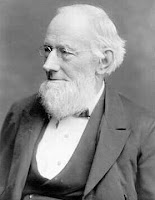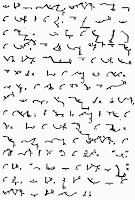Sunday, 17 July 1881 - Birmingham, UK
Today I attended the service at Holy Trinity Church in the Bordesley area of Birmingham. Built in 1823 it is the second Gothic Revival style church in the area. As lovely as the church is, I was really asked here by the University of Birmingham to record a martyr.
 |
| Holy Trinity Church |
Fortunately this is the Victorian Age and the British no longer burn heretics at the stake. Now they can toss them into jail, and then only if they are priests in the Church of England. That is what happened to Rev. Richard William Enraght. Last November on the 27th he was arrested and tossed into prison for 49 days.
Rev. Richard William Enraght horrible crimes were:
1. adoration of the Blessed Sacrament,
2. the use of eucharistic candles,
3. wearing the chasuble and alb,
4. using wafers in Holy Communion,
5. ceremonial mixing of water and communion wine,
6. making the sign of the Cross towards the congregation,
7. bowing his head at the Gloria,
8. allowing the Agnus Dei to be sung.
 |
| Rev. Richard William Enraght |
In doing this he broke the law and was prosecuted under the Public Worship Regulation Act passed in 1874. How did Parliament get involved with what should have been a church matter? It all started with Henry VIII.
At first King Henry was appalled by Martin Luther’s ideas of a Protestant Reformation. He was a good Catholic boy, even writing a book entitled The Defence of the Seven Sacraments, for which he was awarded the title "Defender of the Faith" by Pope Leo X. Then the Pope refused to give him a divorce, so Henry proclaimed himself now the head of the Church in England and the Pope could shove off. Henry refused the rule of Rome but he did keep that smashing title “Defender of the Faith”.
Problem was that outside of making himself answerable to no one, Henry really hadn’t thought out what this new church should be. Were they Catholic or Protestant? It took his daughter Queen Elizabeth II to come up with a definition she thought would make everyone happy. The Church of England was Catholic AND Protestant.
Turns out a lot of people were not happy. Dissenters appeared almost immediately. Some were crackpots, like the Adamites who believed the only way to recover the lost innocence of Adam and Eve before the fall was to run around naked. (I believe they all froze to death.) There were also the Seekers who felt the True Church was the one Christ would bring to them on His return. So they would meet every Sunday to sit in silence, waiting in vain for Jesus to walk in. Neither sect lasted long.
Saner sects broke off either quietly like the Methodists or violently like the Puritans who took over the country with Oliver Cromwell. The one thing all the dissenters agreed on was they opposed state interference in religious matters. Parliament slowly agreed with that except when it came to Church of England matters.
In the meantime Catholicism had been outlawed. Killing Catholics proved not only messy, but created martyrs. So Parliament came up with a sneakier plan. Catholics were stripped of the right to vote, hold property, travel, worship openly, etc. Martyrdom might be romantic, but repression was just depressing. Still some stubbornly held onto their Catholic faith.
Then at the beginning of the 19th century two things happened that made Parliament rethink their oppression of Catholics.. Refugees were pouring into Britain from France trying to escape the French Revolution. Not only were the Revolutionists beheading nobility, they were going after Catholics as well. The French wanted to wipe the slate completely clean to start a new society--unfortunately in their zeal they rubbed a hole in said slate.
The second event happened in 1800 when the United Kingdom of Great Britain and Ireland was formed. Suddenly the country had a whole Emerald Isle full of Catholics. Parliament was forced to slowly start abolishing those repressive laws until the Catholic Emancipation Act of 1832 erased all of them. Now Catholics were full citizens allowed to practice their religion openly. What happened next, no one saw coming.
Curious Anglicans began showing up to watch these mysterious Catholic services. In the last 300 years, the Church of England had been stripping away the old traditions. Most visitors walked away thinking, “Well, that was boring. Glad we modernized.” However some thought, “How beautiful! Why don’t we have all those lovely rituals anymore?”
A group, calling themselves the Oxford Movement worked to make the Church of England more Catholic. They were deemed dangerous radicals. Making the Church more Catholic might lead to it becoming too Catholic and winding up back under the rule of the Church of Rome. Good or bad, it was England’s Church, and neither the Crown or Parliament wanted to lose it to some Pope. So they stepped in with the Public Worship Regulation Act to give the Archbishop of Canterbury all the help he wanted.
 |
A cartoon from Punch, 18 December 1869
Archbishop Tait uses the crook "Public Worship Regulation Bill"
trying to control the black sheep of "Ritualism" before they
jump the fence of the "Established Church" and run off "To Rome" |
Not everyone in Parliament wanted the Act. This was a Church matter, not a State matter. Let the Archbishop Tait handle it, they said. If a clergyman disobeyed, the head of the church (Her Majesty) could just send off a nasty notice telling him he was sacked. But arresting and imprisoning? That was a bit too much.
They weren’t the only ones thinking so. When Enraght was arrested the public outcry was deafening. Newspapers here and abroad condemned the arrest. A huge rally that filled the Birmingham Town Hall protested the imprisonment. Enraght was released from prison early, much to the relief of the Warden who felt rather distressed at having to lock up a religious martyr.
I noticed today Enraght did a full Catholic communion. He learned nothing from his incarceration--and neither did Parliament. In a couple of years they will threaten him with imprisonment again. This time Bishop Philpott will just evict him from Holy Trinity to avoid the embarrassment.
Eventually many chaps in the Oxford Movement will decide to just turn their backs on the Church of England and “return” to the Catholic Church. I think part of the appeal of the Catholic Church to intellectuals is the fact that this is the religion of the Medieval Period which the Victorians long for. The world is changing far too fast for many of them and they long for the past. Never mind that it is a past grounded in fantasy rather than reality. Middle Ages was a dreadful period and none of them would really have liked living there.
Still one has to admire Rev. Richard William Enraght for sticking up for his convictions. Most men would have knuckled under. Four other clergymen will also suffer his martyrdom. Persecutions will end in 1906, although the Act itself won’t be repealed until 1965. Everyone felt good riddance to the silly law. Never mix politics and religion.
A List of clergymen imprisoned under
the Public Worship Regulation Act:
- T. Pelham Dale, Rector of St Vedast Foster Lane, London, 1880
- Richard William Enraght, Rector of Holy Trinity, Bordesley, 1880
- Sidney Faithorn Green, Rector of St John's, Manchester, 1881–82
- Arthur Tooth, Vicar of St James's, Hatcham, 1877
- James Bell Cox, Vicar of St Margaret's, Liverpool 1887




































